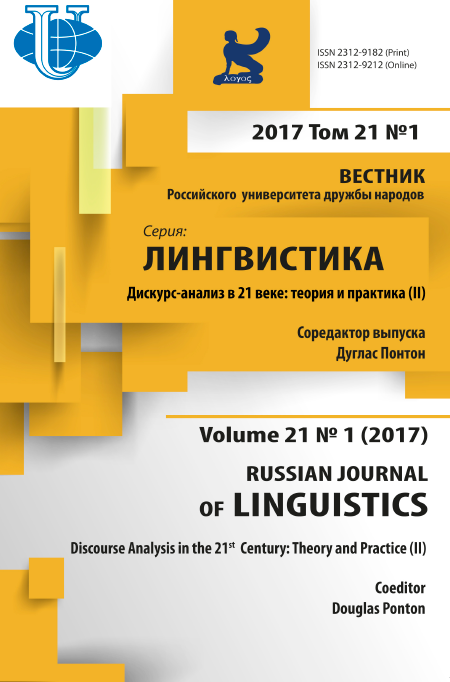Discourse Motivations of Mental Construal and the Expression of Stance in Speech: A Case Study of English
- Authors: Khrisonopulo E.Y.1
-
Affiliations:
- Saint-Petersburg State University of Culture
- Issue: Vol 21, No 1 (2017): Discourse Analysis in the 21 st Century: Theory an d Practice (II)
- Pages: 91-104
- Section: Articles
- URL: https://journals.rudn.ru/linguistics/article/view/15406
- DOI: https://doi.org/10.22363/2312-9182-2017-21-1-91-104
Cite item
Full Text
Abstract
This paper presents an account of the phenomenon of mental construal manifested in English expressions of stance through the distinction of clauses that are headed by subjects associated with two conceptual archetypes: participant (P) invoked by the first-person pronoun ( I am certain that ) and abstract setting (S) conveyed by anticipatory it ( It is certain that ). With recourse to the main theoretical points on the anchoring of linguistic meaning in the acts of speech activity (Leontiev A.A.), mental construal (Langacker R.), processes of discourse-driven conceptualization and categorization (Kubryakova E.S.) and with reference to discourse oriented studies of stance (Biber D., Finegan E., Kärkkäinen E.), the conducted analysis focuses on a corpus of about 350 examples that represent narrative and dialogic discourse in English-language fiction. As evidenced by linguistic data, the choice of stance expressions with P- and S-subjects is motivated, respectively, by the distinctions that arise in discourse between actual and mentally represented types of reality, the contrast between reference-making and viewing as types of cognitive events and the distinction between event-schemas and mental experiences. These discursively relevant distinctions are further shown to be related to narrative and dialogic strategies that are used in literary texts for the expression of stance with the alternative stance-clauses.
About the authors
Ekaterina Yu Khrisonopulo
Saint-Petersburg State University of Culture
Email: hrisonopulo@mail.ru
2, Dvortsovaya nab., Saint-Petersburg, Russia, 191186
References
- Кубрякова Е.С. Номинативные аспекты речевой деятельности. М.: Наука, 1986. [Kubryakova E.S (1986). Nominativnyi aspekt rechevoi deyatel’nosti. Moscow: Nauka. (In Russ).]
- Кубрякова Е.С. В поисках сущности языка. Когнитивные исследования // Институт языкознания РАН. М.: Знак, 2012. [Kubryakova E.S. (2012) V poiskakh sushchnosti yazyka. Kognitivnye issledovaniya / Institut yazykoznaniya RAN. Moscow: Znak. (In Russ).]
- Кубрякова Е.С. Язык и знание: на пути получения знания о языке: части речи с когнтивной точки зрения. Роль языка в познании мира // Институт языкознания РАН. М.: Языки Славянских культур, 2004. [Kubryakova E.S. Yazyk i znaniye: Na puti polucheniya znanij o yazyke: Chasti rechi s kognitivnoj tochki zreniya. Rol’ yazyka v poznanii mira / Institut yazykoznaniya RAN. Moscow: Yazyki Slavyanskikh Kultur. (In Russ).]
- Сидоров Е.В. Онтология дискурса. 2-е изд. М.: Либроком, 2009. [Sidorov E.V. (2009). Ontologiya diskursa. 2nd ed. Moscow: Librokom. (In Russ).]
- Сидоров Е.В. Порядок текста. М.: Российский государственный социальный университет, 2011. [Sidorov E.V. (2001). Poryadok teksta. Moscow: Russian State Social University. (In Russ).]
- Berman, R.A. (2004). Introduction: developing discourse stance in different text types and languages. Journal of Pragmatics, 2004, 37, 105-124
- Biber, D. and Finegan, E. (1989). Styles of stance in English: lexical and grammatical marking of evidentiality and affect. Text, 9(1), 93-124
- Biber, D., Johansson, S., Leech, G., Conrad, S. and Finegan, E. (2004). Longman grammar of spoken and written English. Harlow: Pearson Education Limited
- Bottineau, D. (2010). Language and enaction. In Stewart J., O. Gappenne, E. Di Paolo (eds.). Enaction: toward a new paradigm of cognitive science. Cambridge: The MIT Press. 267-306
- Du Maurier, D. (2006) The rendezvous and other stories. Great Britain: Virago Press
- Garrod, S. and. Pickering, M.J. (2004). Why is conversation so easy? Trends in Cognitive Sciences, 8, 8-11
- Garrod, S. and Pickering, M.J. (2013). Interactive alignment and prediction in dialogue. In Wachsmuth I., J. de Ruiter, P. Jaecks and S. Kopp (eds.). Alignment in communication: towards a new theory of communication. Amsterdam. Philadelphia: John Benjamins. 193-203
- Hyland, K. and P. (2005). Tse Evaluative ‘that’ constructions: signalling stance in research abstracts. Functions of Language, 12(1), 39-63
- Kärkkäinen, E. (2003). Epistemic stance in English conversation: a description of its interactional functions, with a focus on ‘I think’. Amsterdam: John Benjamins
- Kärkkäinen, E. (2006). Stancetaking in conversation: from subjectivity to intersubjectivity. Text and Talk, 26(6), 699-731
- Kärkkäinen, E. (2007). The role of ‘I guess’ in conversational stancetaking. In Englebretson R. (eds.). Stancetaking in discourse: subjectivity, evaluation, interaction. Amsterdam / Philadelphia: John Benjamins, 183-219
- Keysanen, T. (2007). Stancetaking as an interactional activity: challenging the prior speaker. In Englebretson R. (eds). Stancetaking in discourse: subjectivity, evaluation, interaction. Amsterdam / Philadelphia: John Benjamins, 253-282
- Langacker, R.W. (1987). Grammatical ramifications of the setting / participant distinction. In Proceedings of the 13th BLS Annual Meeting, 383-394
- Langacker, R.W. (2000a) Grammar and conceptualization. Berlin; New York: Mouton de Gruyter, 2000a
- Langacker, R.W. (2000b). Why a mind is necessary: conceptualization, grammar and linguistic semantics. In Albertazzi, L. (ed.). Meaning and cognition: a multidisciplinary approach. Amsterdam / Philadelphia: John Benjamins, 25-38
- Langacker, R.W. (2011). On the subject of impersonals. In Brdar M., S.Th. Gries, M.Ž. Fuchs (eds.). Cognitive linguistics: convergence and expansion. Amsterdam / Philadelphia: John Benjamins, 179-217
- Le Carré, J. (2000). The spy who came in from the cold. Great Britain: Coronet Books, 2000
- Leontiev, A.A. (2000). The heuristic principle in the perception, emergence, and assimilation of speech. In Lenneberg Eric H. and Elizabeth Lenneberg (eds). Foundations of language development: a multidisciplinary approach. Paris: The UNESCO Press, 1975. 43-58
- Leontiev, A.A. (1981). Sign and activity. In Wertsch J.W. (eds). The concept of activity in Soviet psychology. New York: M.E. Sharpe, Inc., Publisher, 241-255
- Leontiev, A.A. (2006a). Psycholinguistic units and speech generation. Journal of Russian and East European Psychology, 2006a, 44 (4), 7-88
- Leontiev, A.A. (2006b). Units and levels of activity. Journal of Russian and East European Psychology, 44 (3), 30-46
- Stewart, J., O. Gapenne and E.A. Di Paolo (eds.). Enaction: toward a new paradigm of cognitive science. Cambridge: The MIT Press, 2010. XVIII

















